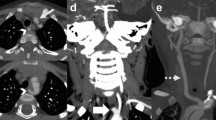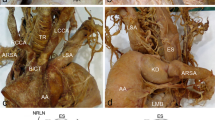Abstract
We describe a rare constellation of variant anatomy of the aortic arch branches, seen on a magnetic resonance angiographic examination during the course of investigation for recent onset memory loss in a 52-year-old patient. There was a common origin of both the common carotid arteries (CCA), the common trunk being the first major branch of the aortic arch, the right vertebral artery arising from the right CCA and the right subclavian artery arising as the last branch of the arch. In isolation, the three components of this constellation have been reported with different frequencies, but as per the authors’ knowledge, this entire constellation has been rarely reported. We review the literature and propose an embryological mechanism for this variant anatomy.
Similar content being viewed by others
Avoid common mistakes on your manuscript.
Introduction
The aortic arch and its three major branches, viz. brachiocephalic, left common carotid and subclavian artery, as well as their secondary branches develop by a fascinating and highly complex sequence of formation and resorption of channels during the embryonic life [4, 5, 8, 9, 14]. Thus is offered scope for development of a variety of variations. These variations become important in the clinical scenario, sometimes directly responsible for clinical manifestations and sometimes causing problems to the physicians in making diagnoses, performing procedures or leading to inadvertent complications [6, 7, 10, 11, 14].
Case report
A 52-year-old woman presented with recent onset and rapidly progressive memory loss with incoherent behaviour. She had no antecedent or significant surgical or medical history. Her general physical examination and routine laboratory tests were within normal limits. A magnetic resonance imaging (MRI) scan of the brain showed signal changes in bilateral temporal–parietal–occipital cortices and differential diagnoses of prion disease or autoimmune encephalitis were kept. Simultaneously, an unenhanced magnetic resonance angiography (MRA) examination of the head and neck vessels was also done as a clinical differential of vascular aetiology of her symptoms had also been thought of.
On MRA, a constellation of variations were noted in the anatomy of the aortic arch branches (Fig. 1). There was a common origin of the common carotid arteries (CCA), the common trunk being the first major branch of the arch, the right vertebral artery (RVA) arose from the right CCA and the right subclavian artery (RSA) came as the last branch of the arch.
Arch CEMRA, MIP image, posterior and slightly oblique view: there is a common origin of both CCA (single arrow), the RSA arises from the posterior surface of the arch as its last branch (double arrow), and the right VA arises from the right CCA (multiple small arrows). CCA common carotid artery, VA vertebral artery, RSA right subclavian artery, MIP maximum intensity projection, CEMRA contrast enhanced magnetic resonance angiography
The upper cervical and intracranial arterial trees were within normal limits (figure not shown).
The patient was put on treatment for autoimmune encephalitis and her symptoms have stabilised, even though she remains dependent.
Discussion
The aortic arch and its major branches develop by a sequence of formation and resorption of multiple vascular channels in the embryonic life, and have been well documented in standard literature [5, 8, 14].
In isolation, various variations are noted, some of the relatively commoner ones being the common origin of brachiocephalic and left CCA (the so-called ‘bovine origin’), LVA rising directly from arch and RSA arising as last branch of the arch [2, 3, 6, 9, 12, 15]. Variations in RVA are much less common, and so are constellations of variations in a single person [2, 3, 6, 9, 12, 15].
The embryological mechanisms of the arch variations in our case can be deciphered by the descriptions and the schema given in standard textbooks, and discussed below [5] (Fig. 2).
Schema of development of the variations in our case: the cervical intersegmental longitudinal anastomosis has regressed between CIA 6 and 7 and the right dorsal aorta has regressed before CIA 7, note the common origin of the carotid arteries. The dashed lines are the parts which disappear during embryogenesis. RCCA right common carotid artery, LCCA left common carotid artery, III third aortic arch, IV fourth aortic arch, RVA right vertebral artery, RSA right subclavian artery, LVA left vertebral artery, LSA left subclavian artery, CIA cervical intersegmental artery
Our case can be explained by splitting the observations into two (1) RVA origin from RCCA, which is associated with aberrant RSA, and (2) common origin of the two CCA (truncus bicaroticus).
The vertebral artery is considered to have the most constant origin among all the branches of the subclavian artery, and the commonest variation in the origin of the vertebral artery is that of the LVA directly arising from the aortic arch, which is seen in about 3 % of the population [16]. Other variations are very rare and include entities such as origin of RVA from aorta distal to that of the LSA, both vertebral arteries arising from the arch, and the vertebral artery arising from the carotid arteries [2, 3, 5, 6, 9, 12, 14, 15].
The vascular development is influenced by rheologic and tension mechanics. The continuous process of formation and resorption of the primitive vessels results in tension and blood tends to flow into the channels which offer least resistance. This results in the survival of the channels offering least tension and resistance to flow while those with higher tension or resistance to flow perish [4].
A longitudinal anastomosis between the dorsal cervical intersegmental arteries (CIA) leads to formation of the vertebral arteries. During embryogenesis, the aorta shifts caudally, creating longitudinal tension and bending of the proximal parts of the intersegmental arteries, resulting in decreased blood flow. This offers opportunity for anomalies to creep in, with the scope for formation of abnormal connections between the developing vertebral artery and the adjacent large arteries offering less resistance [16].
Thus, if the longitudinal anastomosis of the right cervical intersegmental arteries stops between the 6th and 7th CIA, and the obliteration of the right dorsal aorta occurs proximal to the 7th CIA, there can be development of an aberrant RSA and variant origin of RVA from RCCA. This also explains why the origin of RVA from RCCA occurs almost exclusively in presence of an aberrant RSA arising distal to the LSA [12]. This pattern in RVA origin is seen on right side (Type I), while another pattern is seen on the left side (Type II). In this situation, the LVA arises from LCCA, however there is lack of aberrant origin of the LSA [3].
The second portion of constellation can develop if there is persistence of the arrangement existing during early gestation period, when the third pair of aortic arch gives rise to the left and right CCA, both vessels originating from embryonic ventral aorta as a common vascular trunk.
Apart from these fascinating anatomic and embryologic discussions, the clinical significance cannot be overemphasized, whether it is from the point of view of the cardiothoracic surgeon, the neurosurgeon, the radiologist, endovascular specialists, trauma specialists or even residents, and nurses [7, 10, 11]. Also, the aberrant RSA is known to cause dysphagia lusoria [8]. Various syndromes and other anomalies and variations have been reported to be associated with the common origin of the common carotids with or without the anomalous RSA. These include esophageal atresia-tracheoesophageal fistula, DiGeorge anomaly, and anomalous origin of the left coronary artery from the pulmonary artery, congenital polyvalvular disease, truncus arteriosus, aorticopulmonary window, trisomy 13, 18, and 21 syndromes, acrocephalosyndactyly (especially Apert syndrome), tetralogy of Fallot not associated with DiGeorge anomaly, and clinical Noonan phenotype [17].
The report would be incomplete without mentioning the technology which detected this variation, i.e., the MRA. It offers a quick, non-invasive, highly sensitive, and specific tool to describe the anatomy of the larger arteries and with its widespread usage, more and more such variations in patient as well as normal population would be picked up for sure [1, 13]. Thus it offers a potential for a more accurate analysis of the vascular anatomy and embryology in vivo, not possible in earlier days, even though catheter angiography and microangiography have been available since quite some time.
Conclusion
We present a rare case of a constellation of variations in the aortic arch branches consisting of common origin of both CCA, aberrant RSA and RVA arising from RCCA, and discuss the plausible embryology. The variations were detected incidentally in a 52-year-old female, during an MRA examination, being performed for evaluation of rapid onset dementia.
References
Carpenter JP, Holland GA, Golden MA, Barker CF, Lexa FJ, Gilfeather M, Schnall MD (1997) Magnetic resonance angiography of the aortic arch. J Vasc Surg 25(1):145–151
Chahwan S, Miller MT, Kim KA, Mantell M, Kirksey L (2006) Aberrant right subclavian artery associated with a common origin of carotid arteries. Ann Vasc Surg 20(6):809–812
Chen CJ, Wang LJ, Wong YC (1998) Abnormal origin of the vertebral artery from the common carotid artery. Am J Neuroradiol 19:1414–1416
Congdon ED (1922) Transformation of the aortic-arch system during the development of the human embryo. Contrib Embryol Carnegie Inst 68:47–110
Haughton VM, Rosenbaum AE (1974) The normal and anomalous aortic arch and brachiocephalic arteries. In: Newton TH, Potts DG (eds) Radiology of the skull and brain, Book 2, Mosby 2, St Louis, pp 1145–1163
Hornick M, Moomiaie R, Mojibian H, Ziganshin B, Almuwaqqat Z, Lee ES, Rizzo JA, Tranquilli M, Elefteriades JA (2012) ‘Bovine’ aortic arch—a marker for thoracic aortic disease. Cardiology 123(2):116–124. doi:10.1159/000342071 Epub 2012 Sep 28
Hsia TY, Kirkham F, Waldman A, Tsang V (2001) The implications of extensive cerebral vascular dysplasia in surgical repair of coarctation of the aorta and ventricular septal defect. J Thorac Cardiovasc Surg 121:998–1001
Kau T, Sinzig M, Gasser J, Lesnik G, Rabitsch E, Celedin S, Eicher W, Illiasch H, Hausegger KA (2007) Aortic development and anomalies. Semin intervent Radiol 24(2):141–152. doi:10.1055/s-2007-980040
Lemke AJ, Benndorf G, Liebig T, Felix R (1999) Anomalous origin of the right vertebral artery: review of the literature and case report of right vertebral artery origin distal to the left subclavian artery. Am J Neuroradiol 20:1318–1321
Matula C, Trattnig S, Tschabitscher M, Day JD, Koos W (1997) The course of the prevertebral segment of the vertebral artery: anatomy and clinical significance. Surg Neurol 48:125–131
Mittendorf E, Marks JM, Berk T, Santoscoy C (1998) Anomalous vertebral artery anatomy and the consequences of penetrating vascular injuries. J Trauma 44:548–551
Park JK, Kim SH, Kim BS, Choi G (2008) Two cases of aberrant right subclavian artery and right vertebral artery that originated from the right common carotid artery. Korean J Radiol 9:S39–S42. doi:10.3348/kjr.2008.9.s.s39
Salanitri J (2005) MR angiography of aberrant left subclavian artery arising from right-sided thoracic aortic arch. Br j radiol 78(934):961–966
Stojanovska J, Cascade PN, Chong S, LE Quint, Sundaram B (2102) Embryology and imaging review of aortic arch anomalies. J Thorac Imaging 27(2):73–84. doi:10.1097/RTI.0b013e318218923c PMID: 21654534
Ugurlucan M, Sayin OA, Surmen B, Alpagut U, Dayioglu E, Onursal E (2006) Common carotid trunk & right vertebral artery originating from the right common carotid artery in a patient with carotid stenosis. J Card Surg 21:423–424
Vorster W, duPlooy PT, Meiring JH (1998) Abnormal origin of internal thoracic and vertebral arteries. Clin Anat 11:33–37
Wells TR, Landing BH, Shankle WR (1993) Syndromal associations of common origin of the carotid arteries. Pediatr Pathol 13(2):203–212
Conflict of interest
None.
Author information
Authors and Affiliations
Corresponding author
Rights and permissions
About this article
Cite this article
Kumar, S., Kumar, P. Truncus bicaroticus with aberrant right subclavian artery and origin of right vertebral from right common carotid artery. Surg Radiol Anat 36, 829–831 (2014). https://doi.org/10.1007/s00276-013-1232-z
Received:
Accepted:
Published:
Issue Date:
DOI: https://doi.org/10.1007/s00276-013-1232-z






